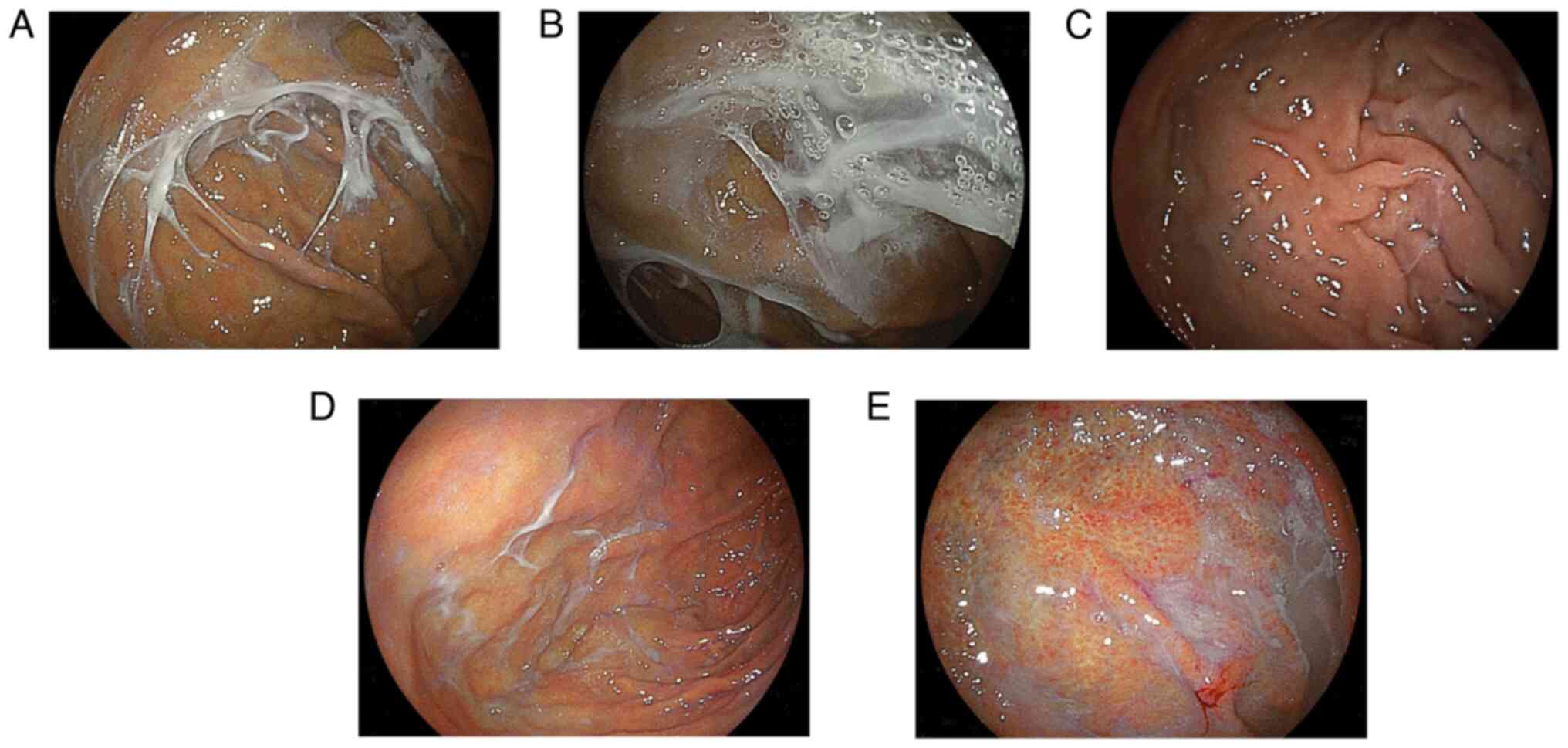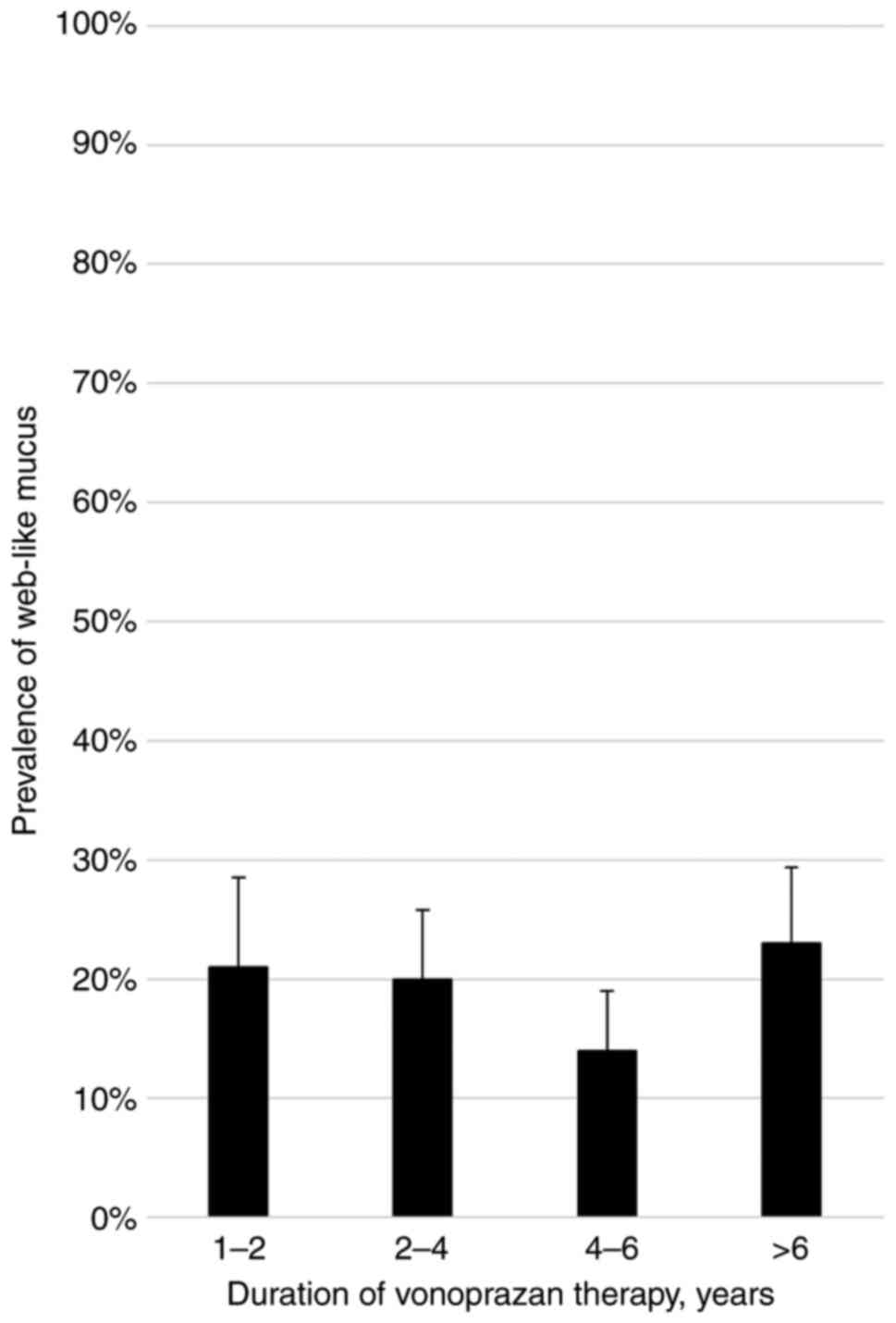|
1
|
Yamamichi N, Shimamoto T, Takahashi Y,
Takahashi M, Takeuchi C, Wada R and Fujishiro M: Trends in proton
pump inhibitor use, reflux esophagitis, and various upper
gastrointestinal symptoms from 2010 to 2019 in Japan. PLoS One.
17(e0270252)2022.PubMed/NCBI View Article : Google Scholar
|
|
2
|
Iwakiri K, Fujiwara Y, Manabe N, Ihara E,
Kuribayashi S, Akiyama J, Kondo T, Yamashita H, Ishimura N,
Kitasako Y, et al: Evidence-based clinical practice guidelines for
gastroesophageal reflux disease 2021. J Gastroenterol. 57:267–285.
2022.PubMed/NCBI View Article : Google Scholar
|
|
3
|
GBD 2017 Gastro-oesophageal Reflux Disease
Collaborators. The global, regional, and national burden of
gastro-oesophageal reflux disease in 195 countries and territories,
1990-2017: A systematic analysis for the Global Burden of Disease
Study 2017. Lancet Gastroenterol Hepatol. 5:561–581.
2020.PubMed/NCBI View Article : Google Scholar
|
|
4
|
Yoshizaki T, Morisawa T, Fujinami M,
Matsuda T, Katayama N, Inoue K, Matsumoto M, Ikeoka S, Takagi M,
Sako T, et al: Propensity score matching analysis: Incidence and
risk factors for ‘stardust’ gastric mucosa, a novel gastric finding
potentially induced by vonoprazan. Aliment Pharmacol Ther.
53:94–102. 2021.PubMed/NCBI View Article : Google Scholar
|
|
5
|
Shinozaki S, Osawa H, Miura Y, Nomoto H,
Sakamoto H, Hayashi Y, Yano T, Despott EJ and Yamamoto H:
Endoscopic findings and outcomes of gastric mucosal changes
relating to potassium-competitive acid blocker and proton pump
inhibitor therapy. DEN Open. 5(e400)2024.PubMed/NCBI View
Article : Google Scholar
|
|
6
|
Kubo K, Kimura N and Kato M:
Potassium-competitive acid blocker-associated gastric mucosal
lesions. Clin Endosc. 57:417–423. 2024.PubMed/NCBI View Article : Google Scholar
|
|
7
|
Kaneko H, Sato H, Suzuki Y, Ikeda A,
Kuwashima H, Ikeda R, Sato T, Irie K, Sue S and Maeda S: A novel
characteristic gastric mucus named ‘Web-like Mucus’ potentially
induced by vonoprazan. J Clin Med. 13(4070)2024.PubMed/NCBI View Article : Google Scholar
|
|
8
|
Kimura K and Takemoto T: An endoscopic
recognition of the atrophic border and its significance in chronic
gastritis. Endoscopy. 1:87–97. 1969.
|
|
9
|
Skoczylas T, Sarosiek I, Sostarich S,
McElhinney C, Durham S and Sarosiek J: Significant enhancement of
gastric mucin content after rabeprazole administration: Its
potential clinical significance in acid-related disorders. Dig Dis
Sci. 48:322–328. 2003.PubMed/NCBI View Article : Google Scholar
|
|
10
|
Kinoshita Y, Haruma K, Yao T, Kushima R,
Akiyama J, Kanoo T, Miyata K, Kusumoto N and Uemura N: Ep54 Final
Observation Results of Vision Trial: A Randomized, Open-Label Study
to Evaluate the Long-Term Safety of Vonoprazan as Maintenance
Treatment in Patients with Erosive Esophagitis. Gastroenterology.
164:S–1202. 2023.
|
|
11
|
Shinozaki S, Osawa H, Miura Y, Hayashi Y,
Sakamoto H, Yano T, Lefor AK and Yamamoto H: Long-term changes in
serum gastrin levels during standard dose vonoprazan therapy. Scand
J Gastroenterol. 57:1412–1416. 2022.PubMed/NCBI View Article : Google Scholar
|
|
12
|
Shiotani A, Katsumata R, Gouda K,
Fukushima S, Nakato R, Murao T, Ishii M, Fujita M, Matsumoto H and
Sakakibara T: Hypergastrinemia in Long-Term Use of Proton Pump
Inhibitors. Digestion. 97:154–162. 2018.PubMed/NCBI View Article : Google Scholar
|
|
13
|
Niv Y and Boltin D: Secreted and
membrane-bound mucins and idiopathic peptic ulcer disease.
Digestion. 86:258–263. 2012.PubMed/NCBI View Article : Google Scholar
|
|
14
|
Sakai T, Ishihara K, Saigenji K and Hotta
K: Recovery of mucin content in surface layer of rat gastric mucosa
after HCl-aspirin-induced mucosal damage. J Gastroenterol.
32:157–163. 1997.PubMed/NCBI View Article : Google Scholar
|
|
15
|
Lanas Á, Carrera-Lasfuentes P, Arguedas Y,
García S, Bujanda L, Calvet X, Ponce J, Perez-Aísa Á, Castro M,
Muñoz M, et al: Risk of upper and lower gastrointestinal bleeding
in patients taking nonsteroidal anti-inflammatory drugs,
antiplatelet agents, or anticoagulants. Clin Gastroenterol Hepatol.
13:906–912.e902. 2015.PubMed/NCBI View Article : Google Scholar
|
|
16
|
Blandizzi C, Gherardi G, Marveggio C,
Natale G, Carignani D and Del Tacca M: Mechanisms of protection by
omeprazole against experimental gastric mucosal damage in rats.
Digestion. 56:220–229. 1995.PubMed/NCBI View Article : Google Scholar
|
|
17
|
Kawai T, Oda K, Funao N, Nishimura A,
Matsumoto Y, Mizokami Y, Ashida K and Sugano K: Vonoprazan prevents
low-dose aspirin-associated ulcer recurrence: Randomised phase 3
study. Gut. 67:1033–1041. 2018.PubMed/NCBI View Article : Google Scholar
|
|
18
|
Lombardo L, Foti M, Ruggia O and Chiecchio
A: Increased incidence of small intestinal bacterial overgrowth
during proton pump inhibitor therapy. Clin Gastroenterol Hepatol.
8:504–508. 2010.PubMed/NCBI View Article : Google Scholar
|
|
19
|
Sanduleanu S, Jonkers D, De Bruine A,
Hameeteman W and Stockbrügger RW: Non-Helicobacter pylori bacterial
flora during acid-suppressive therapy: Differential findings in
gastric juice and gastric mucosa. Aliment Pharmacol Ther.
15:379–388. 2001.PubMed/NCBI View Article : Google Scholar
|
|
20
|
Minalyan A, Gabrielyan L, Scott D, Jacobs
J and Pisegna JR: The gastric and intestinal microbiome: Role of
proton pump inhibitors. Curr Gastroenterol Rep.
19(42)2017.PubMed/NCBI View Article : Google Scholar
|












